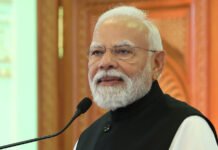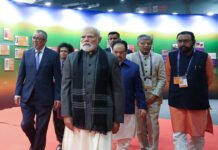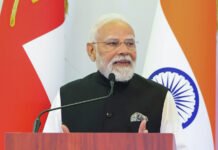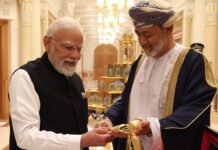 { Nirendra Dev } A high spot of the economic scene in a normal circumstance in a parliamentary democracy is the presentation of the budget. But this fiscal, the major highlight could be the launching of ‘Make in India’ campaign by the Prime Minister Narendra Modion September 25, 2014.
{ Nirendra Dev } A high spot of the economic scene in a normal circumstance in a parliamentary democracy is the presentation of the budget. But this fiscal, the major highlight could be the launching of ‘Make in India’ campaign by the Prime Minister Narendra Modion September 25, 2014.
The initiative basically promises the investors – both domestic and overseas – aconducive environment to turn 125 crore population strong-India a manufacturing hub and something that will also create job opportunities.
That’s in effect a plunge into a serious business but it is also punctuated with two inherent elements in any innovation – new avenues or tapping of opportunities and facing the challenges to keep the right balance. The political leadership is widely expected to be populist; but ‘Make in India’ initiative is actually seen as a judicious mix of economic prudence, administrative reforms and thus catering to the call of people’s mandate – an aspiring India.
In the words of the Prime Minister Shri Narendra Modi, “the biggest requirement is trust, confidence. I don’t know how we have run our country that we have doubted our own countrymen at every turn. I need to change this vicious cycle. We should not start from distrust, we should begin with trust”. And then he adds on rather aptly: “the government should intervene only if there’s some shortcomings”.
True to the spirit of this visionary statement, the ‘Make in India’ policyprogramme also commits that the campaign “represents an attitudinal shift in how India relates to investors: not as a permit-issuing authority, but as a true business partner.”
PM Narendra Modi first made the pitch for ‘Make in India’ during his maiden Independence Day speech from the ramparts of Red Fort “If we have to put in use the education, the capability of the youth, we will have to go for manufacturing sector and for this Hindustan also will have to lend its full strength, but we also invite world powers. Therefore I want to appeal all the people world over, from the ramparts of the Red Fort, “Come, make in India”, “Come, manufacture in India”. Sell in any country of the world but manufacture here. We have got skill, talent, discipline, and determination to do something. We want to give the world an favourable opportunity that come here, “Come, Make in India” and we will say to the world, from electrical to electronics, “Come, Make in India”, from automobiles to agro value addition “Come, Make in India”, paper or plastic, “Come, Make in India”, satellite or submarine “Come, Make in India”. Our country is powerful. Come, I am giving you an invitation. Brothers and sisters, I want to call upon the youth of the country, particularly the small people engaged in the industrial sector. I want to call upon the youth working in the field of technical education in the country. As I say to the world “Come, Make in India”, I say to the youth of the country – it should be our dream that this message reaches every corner of the world, “Made in India”. This should be our dream.
This is a path-breaking venture. In fact, the vision statement of official website,www.makeinindia.gov.in commits to achieve for the country among other things an increase in manufacturing sector growth to 12-14 % per annum over the medium term, increase in the share of manufacturing in the country’s Gross Domestic Product from 16% to 25% by 2022 and importantly to create 100 million additional jobs by 2022 in the manufacturing sector alone. These are quite highly ambitious targets given the background that the manufacturing sector in India, which accounts for fourth-fifth of the total output, grew a meagre 3.3 per cent in January 2010.
Achievable Targets:
· Target of an increase in manufacturing sector growth to 12-14% per annum over the medium term.
· An increase in the share of manufacturing in the country’s Gross Domestic Product from 16% to 25% by 2022.
· To create 100 million additional jobs by 2022 in manufacturing sector.
· Creation of appropriate skill sets among rural migrants and the urban poor for inclusive growth.
· An increase in domestic value addition and technological depth in manufacturing.
· Enhancing the global competitiveness of the Indian manufacturing sector.
· Ensuring sustainability of growth, particularly with regard to environment.
Tapping Golden Opportunity:
Now let us look at the opportunity, the initiative can actually benefit India from the ground reality, especially when the Chinese manufacturing leaps have come under strain. There are already reports that several western manufacturing players operating in China want to move away from the world’s largest manufacturing hub.
Analysts say, Chinese wages are going up and the labour market is getting more challenging and that is driving away investors. Thus companies with operating factories in China should look for other alternatives in the region, such as Vietnam, Indonesia and of course India.
What are the advantages Indian business and especially manufacturing sector actually offer?
The country is expected to rank amongst the world’s top three growth economies and amongst the top three manufacturing destinations by as early as 2020. This is far more ambitious scene than promised about 2050 sometime back in the context of India’s role at the BRICS level. Indian manufacturing sector has positive elements like “favourable demographic dividends” for the next 2-3 decades. The sustained availability of quality workforce is another advantage.
Importantly again, in India, the cost of manpower is relatively low as compared to other countries. There are responsible business houses operating with credibility and professionalism. The country has a democratized polity vis-à-vis the rule of law and a strong consumerism intake ability of the domestic market.
Various speakers on September 25 at the launch of Make in India programme also spoke about robust technical and engineering capabilities backed by top-notch scientific and technical institutes as other positive offerings on the table.
Favourable Milestones:
· India has already marked its presence as one of the fastest growing economies of the world.
· The country is expected to rank amongst the world’s top three growth economies and amongst the top three manufacturing destinations by 2020.
· Favourable demographic dividends for the next 2-3 decades. Sustained availability of quality workforce.
· The cost of manpower is relatively low as compared to other countries.
· Responsible business houses operating with credibility and professionalism.
· Strong consumerism in the domestic market.
· Strong technical and engineering capabilities backed by top-notch scientific and technical institutes.
· Well-regulated and stable financial markets open to foreign investors.
The government has also pledged other focused approaches. Among other things, it intends to leverage the existing incentives/schemes to boost manufacturing.
A technology acquisition and development fund has been proposed for the acquisition of appropriate technologies, the creation of a patent pool and the development of domestic manufacturing of equipment used for controlling pollution and reducing energy consumption, official sources said in New Delhi.
This fund will also function as an autonomous patent pool and licensing agency. It will purchase intellectual property rights from patent holders.
In his speech at the launch of the campaign, the Prime Minister Shri Modi had a vital point to make when he said incentives or tax-free announcements do not win over investors. It is obvious there’s need to create development and growth oriented environment.
The government has also to deal with an existing menace in bureaucratic functioning. The bureaucratic bottle necks that hinder ease of doing business need to be removed.
Training of Workforce:
The manufacturing sector cannot develop on its own without skilled labour force and in this context it is heartening to note the government’s initiatives for skill development. The creation of appropriate skill would definitely set rural migrants and the urban poor on a track towards inclusive growth. That would be a vital step for boosting manufacturing.
The New Ministry for Skill Development and Entrepreneurship has initiated the process of revising the National Policy on Skill Development. It is significant to note that under the Rural Development ministry, the Modi government has undertaken another new initiative for skill development under a recast programme named after BJP icon Pt. Deendayal Upadhyaya.
The new training programme envisages setting up of at least 1500 to 2000 training centres across the country and the entire project would result in an estimated expenditure of Rs 2000 crore and will be run on PPP model.
The new training programme would enable the youths to get jobs in demand-oriented markets like Spain, US, Japan, Russia, France, China, UK and West Asia. The government proposes to train about 3 lakh youths annually in first two years and by the end of 2017, it has set a target of reaching out to as many as 10 lakh rural youths.
Other steps:
As part of other steps, there is need to address other issues too like adequate development of basic infrastructures – the roads and the power chiefly. For long,MNCs and software service companies have relished doing business in India due to a robust market with enhanced purchasing ability of the citizens but in terms of building up ‘manufacturing facilities’, India has been a case of also-ran. In this context it is worth pointing out that a strong political will, business-like approach of bureaucrats and the entrepreneurs, skilled of workforce along with investment friendly policies can unleash the nation’s potential.
It is in this context the government’s efforts to develop an “industrial corridor” between Delhi and Mumbai needs to be appreciated.
The government is also working on multi-pronged strategies like development of infrastructure linkages including pioneer plants, assured water supply, high capacity transportation and logistics facilities.
Carrying on the good works on these fronts, the government also has begun the process of reviving five ailing Public Sector units (PSUs). Of the 11 PSUs, the government also feels that for six other units that needs to be closed, it is working on one-time settlement involving voluntary retirement scheme entailing a cost of Rs1,000 crore VRS for employees.
The state-run units which have been identified by the government for revival include HMT Machine Tools Ltd; Heavy Engineering Corporation; NEPA Ltd; NagalandPaper & Pulp Co Ltd; and Triveni Structurals.
Nirendra Dev
Special Representative with The Statesman and has written books including ‘Modi to Moditva: An Uncensored Truth
Disclaimer : The views expressed by the author in this feature are entirely his own and do not necessarily reflect the views of INVC.
—————————————————————————–

















Informative and precise…
Its hard to find informative and accurate information but here I found…
Excellent site. Plenty of helpful information here. I am sending it to a few buddies ans additionally sharing in delicious. And obviously, thank you to your effort!